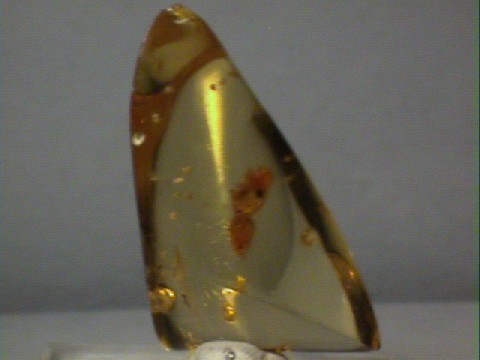
AMBER
Specimen amb-67
$ 45.00
Dims:1.6x1.0x0.6" (4.1x2.5x1.5 cm)
Wt: 0.2oz. (5g)
Boyaca, Columbia
This specimen consists of a fully polished piece of Columbian amber, light honey in color. There are two complete worker termites included in this piece as well as a partial termite. Near one of the termites is another tiny insect that I believe to be a mite of some kind. This specimen would do very well wirewrapped and worn as a necklace. It is of miocene age-approximately 14 million years old.
 Amethyst Galleries' Mineral Gallery MINERALS |

AMBER specimen amb-4
$ 150.00
$ 150.00
Dims: 1-1/2" x 5/8" x 3/4"
Wt: 6.1 g
Poland
A really splendid specimen, this amber chunk has a diversity of insects trapped in it! I count at least 4 mosquitos, 2 flies of indeterminate species, and one grasshopper that has antennae over twice the length of its body! The amber has been polished into a freeform "tumbled" shape and has many carbon inclusions and some huge internal fractures, some of which span the specimen's entire length. I didn't think that this specimen was worth the price until I looked at it closely. Then I changed my mind.
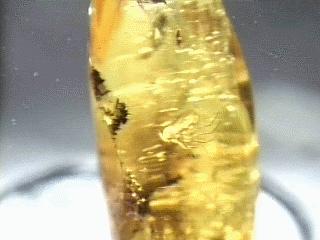

amb-4 ($150.00)
Poland
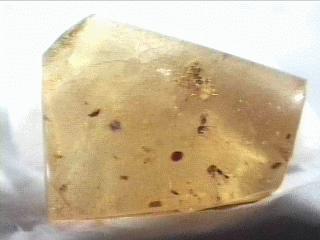
AMBER specimen amb-5
$ 160.00
$ 160.00
Dims: 1-1/2" x 1-1/4" x 1/2"
Wt: 8.3 g
Santander, Colombia
I have counted at least 15 insects in this particular specimen. I have detected at least 2 different species of flies, 2 species of wasps, one tiny spider, and a few indeterminate insect parts, including what appears to be a large head of a fly or a wasp! There is also a mystery inclusion that I am pretty sure is either a seed of some sort or an insect egg casing; it's difficult to tell. Needless to say, this is an amber piece that will keep a person busy for a bit.


amb-5 ($160.00)
Santander, Colombia
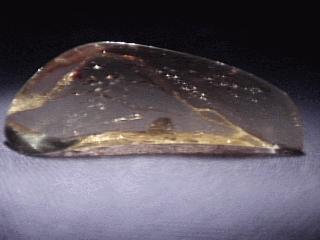
AMBER specimen amb-6
$ 60.00
$ 60.00
Dims: 1.9" x 0.7" x 0.5"(4.8 x 1.8 x 1.3 cm)
Wt: 7.1 g
Boyaca, Colombia
This lovely bit of amber from Columbia is dated to the Miocene epoch, around 14 M.Y.A.(million years ago). It contains air bubbles, one spider, two beetles, a well-preserved fly with its wings easily visible, and what may be a spider with very long legs(a few are missing) or some type of caddis fly- it is difficult to tell.

amb-6 ($ 60.00)
Boyaca, Colombia
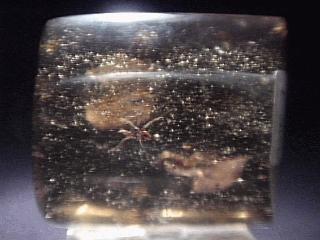
AMBER specimen amb-7
$ 150.00
$ 150.00
Dims: 1.7" x 1.5" x 0.6"(4.3 x 3.8 x 1.5 cm)
Wt: 15.9 g
Boyaca, Colombia
Over 15 insects are trapped in this piece of Columbian amber. It dates back to the Miocene epoch, about 14 M.Y.A., and contains a large, incomplete ant, two mosquitos, several different species of flies, a small beetle, and an insect known as a silverfish. There are also air bubbles, and a few that are two-phased, meaning they contain both air and water- using a loupe, one can see the air bubble move within the inclusion when the specimen is turned about.
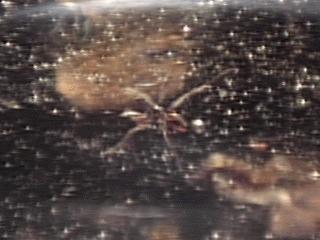

amb-7 ($150.00)
Boyaca, Colombia
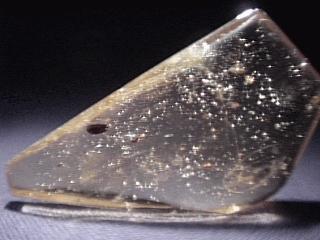
AMBER specimen amb-8
$ 75.00
$ 75.00
Dims: 2.1" x 1.2" x 0.4"(5.3 x 3.0 x 1.0 cm)
Wt: 7.8 g
100 km south of Mombasa, Kenya
At least 15 insects rest in this polished piece of Kenyan Amber. It is dated back to the Miocene epoch and contains at least 2 ants, a spider, a variety of different species of flies, at least one wasp, and a large beetle. A loupe is quite useful when looking at these insects, along with a base that gives off diffuse light.

amb-8 ($ 75.00)
100 km south of Mombasa, Kenya
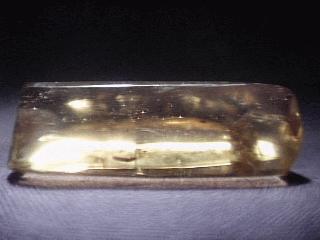
AMBER specimen amb-9
$ 45.00
$ 45.00
Dims: 1.7" x 0.6" x 0.5"(4.3 x 1.5 x 1.3 cm)
Wt: 5.7 g
Boyaca, Colombia
There are well over 20 different insects in this Columbian specimen that dates back to the Miocene epoch(about 14 M.Y.A.). It contains at least one ant, a winged termite, two beetles that may actually be termites without wings, and a large variety of various species of flies. All of these insects are quite small, so a microscope or loupe is suggested.

amb-9 ($ 45.00)
Boyaca, Colombia
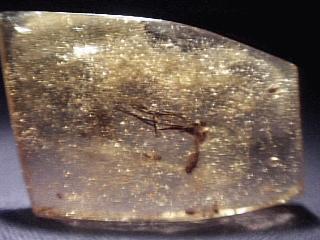
AMBER specimen amb-10
$ 60.00
$ 60.00
Dims: 2.0" x 1.3" x 0.4"(5.1 x 3.3 x 1.0 cm)
Wt: 8.9 g
100 km south of Mombasa, Kenya
Over 10 insects are contained in this specimen, which dates back to the Miocene epoch. There are a variety of flies, at least one wasp, a beetle, an insect that strongly resembles some type of weevil, and what is called a fulgorid. I am thinking that a fulgorid is some type of very large, winged insect with long, thick legs, as the remains of such an insect are partially in the specimen. I am not sure, though- Webster's dictionary gives the definition for the word fulgor as "splendor, a dazzling brightness". I do not see any evidence of a firefly or lightning bug, so I am stumped. Is there an entomologist, or anybody, that can shed light on this?


amb-10 ($ 60.00)
100 km south of Mombasa, Kenya
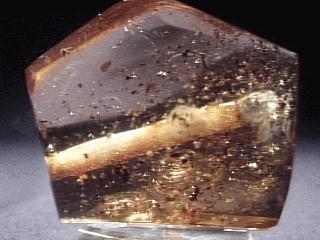
AMBER specimen amb-11
$ 90.00
$ 90.00
Dims: 2.1" x 2.0" x 0.7"(5.3 x 5.1 x 1.8 cm)
Wt: 23.5 g
Boyaca, Colombia
There is so much debris in this specimen that it is difficult to pick out all of the insects! The specimen itself is a piece of Columbian Amber that dates back to the Miocene epoch(about 14 M.Y.A.), and amidst all of the confusion, there are several different species of flies, at least one beetle, what appears to be a large and rather tangled spider, and a long, tubular hollow tunnel that runs the length of the specimen. There are likely more insects in this specimen than those that I have seen.

amb-11 ($ 90.00)
Boyaca, Colombia

AMBER specimen amb-12
$ 60.00
$ 60.00
Dims: 2.5" x 1.5" x 0.6"(6.4 x 3.8 x 1.5 cm)
Wt: 18.0 g
Boyaca, Colombia
I really like this Columbian Amber specimen! It dates back to the Miocene epoch(approx. 14 M.Y.A.) and contains 7 insects, four of which are large worker termites. The others include one ant that is partally obscured by air bubbles, an insect that I think is a tiny silverfish, and a beetle. There also seems to be a small amount of spider web trapped in the specimen. The aspect of this specimen that makes it so attractive to me is the fact that two of the termites have moving air bubbles inside of them, denoting two-phase inclusions! The insects and the bubbles are large enough that one doesn't even need a loupe to see them.

amb-12 ($ 60.00)
Boyaca, Colombia
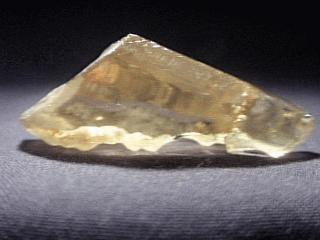
AMBER specimen amb-13
$ 20.00
$ 20.00
Dims: 2.5" x 1.4" x 0.9"(6.4 x 3.6 x 2.3 cm)
Wt: 15.0 g
Santander, Colombia
An extremely simple specimen, this piece of polished Columbian Amber is quite beautiful. It is a pale yellow in color and has no insects or inclusions of any kind. It is almost perfectly clear and has no internal fractures. Two of its sides are polished, enabling one to see into the specimen, whereas two other sides have been left in their natural state, creating a "landscape". This piece could be used as rough to cut a lovely cabochon out of, if someone wanted a flawless amber stone.

amb-13 ($ 20.00)
Santander, Colombia
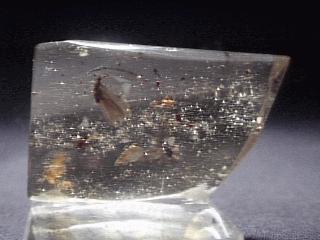
AMBER specimen amb-14
$ 150.00
$ 150.00
Dims: 1.8" x 1.1" x 0.4"(4.6 x 2.8 x 1.0 cm)
Wt: 7.2 g
Boyaca, Colombia
For a small Amber specimen, this polished Columbian piece is simply loaded with insects! There is a small spider, an incomplete but visible leaf-hopper, a winged termite, a winged ant, a large but incomplete ant without wings, and at least one small mosquito. If that isn't enough, there are also several bubbles that exhibit two-phase inclusions! One has a highly portable insect collection in this piece!


amb-14 ($150.00)
Boyaca, Colombia
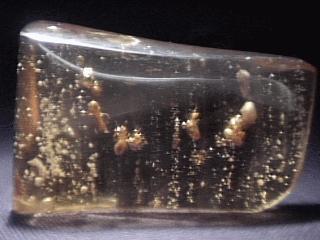
AMBER specimen amb-15
$ 80.00
$ 80.00
Dims: 2.0" x 1.4" x 0.8"(5.1 x 3.6 x 2.0 cm)
Wt: 17.5 g
Boyaca, Colombia
This piece of polished Columbian Amber contains 8 worker termites. They are large enough to easily see with the naked eye, and 7 of them are complete. The best aspect of the specimen, in my opinion, is the fact that at least 4 of these termites have movable air bubbles trapped in their abdomens, denoting . There are also a few of these in regular bubbles scattered inside the piece. The two-phase inclusions can be seen quite clearly inside the termites, even without magnification.
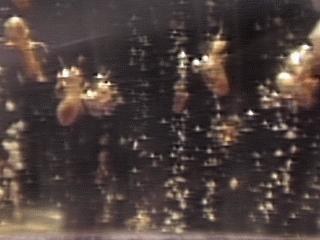

amb-15 ($ 80.00)
Boyaca, Colombia
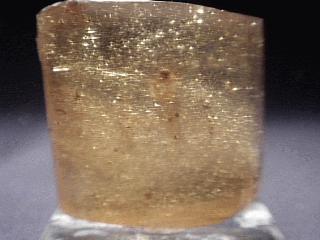
AMBER specimen amb-17
$ 75.00
$ 75.00
Dims: 1.2" x 1.2" x 0.5"(3.0 x 3.0 x 1.3 cm)
Wt: 9.0 g
Boyaca, Colombia
Although the view is hazy and interrupted by hundreds of bubbles, there are a few good insect inclusions in this polished Amber specimen from Columbia. It dates back to the Miocene epoch(approx. 14 M.Y.A.) and contains a rather large, well-preserved spider, two flies, a seed pod or egg-casing of some kind, and a mysterious little object that looks a lot like a tiny mushroom, but could be a seed, an egg casing, or a number of other objects. I really want to find out what this thing is- maybe a nearby university can help me.
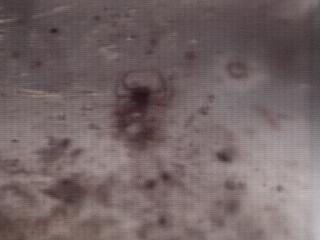

amb-17 ($ 75.00)
Boyaca, Colombia

AMBER specimen amb-18
$ 60.00
$ 60.00
Dims: 3.4" x 2.0" x 0.8"(8.6 x 5.1 x 2.0 cm)
Wt: 1.32 oz.(37.4 g)
Boyaca, Colombia
One of the largest pieces of Amber we have in our stock, this Columbian specimen has many inclusions, but is quite clear, so that details of the things it contains are easy to see. It is dated back to the Miocene epoch(about 14 M.Y.A.) and has 5 termites trapped in it that have good detail and are visible to the naked eye. There are many large air bubbles around the termites, and a large number of very small air bubbles. On examination of these smaller bubbles with a loupe, one can see that they all contain movable air bubbles, denoting two-phase inclusions. There are also several tiny granules, like pieces of sand, trapped in the fossil resin.

amb-18 ($ 60.00)
Boyaca, Colombia
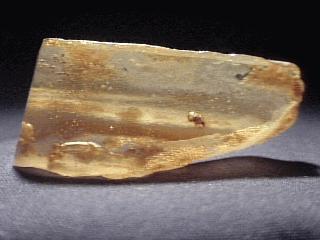
AMBER specimen amb-19
$ 45.00
$ 45.00
Dims: 2.7" x 1.5" x 0.7"(6.9 x 3.8 x 1.8 cm)
Wt: 24.3 g
Boyaca, Colombia
Like other specimens from the kaolinitic clays in Boyaca, this specimen dates back to the Miocene epoch, and is thus about 14 million years old. It contains 5 worker termites, 2 of which are incomplete. There are air pockets near each termite that obstruct the view of them and three sides of the specimen are not polished, further restricting one's line of sight. However, the termites are large enough to see without a loupe or magnifier, and are clearly visible. There are also at least 20 egg casings of unknown origin- some of these seem to be misshapen, as if they were balloons that were partially deflated. Upon close examination with my trusty 10-power loupe, I noticed that most, if not all, of these contain the moving air bubbles that denote two-phase inclusions.

amb-19 ($ 45.00)
Boyaca, Colombia
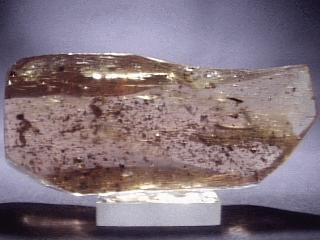
AMBER specimen amb-21
$ 150.00
$ 150.00
Dims: 3.5" x 1.6" x 0.9"(8.9 x 4.1 x 2.3 cm)
Wt: 1.53 oz.(43.4 g)
100 km south of Mombasa, Kenya
A rather large Kenyan Amber specimen, this piece dates back to the Miocene epoch (about 14 M.Y.A.) and has so many inclusions that sorting out all those of insect origin would take hours! I am not even going to attempt to count all of them, but I know that there are over 50, and possibly over 100! These include a variety of flies, a winged termite, a winged ant, several ants without wings, at least one worker termite, a spider, a small wasp, several mosquitos, a small leaf, and part of a stem from a leaf. There are also several very large legs that are not attached to the body of their owner. There are also the standard air bubbles and what appear to be a cluster of eggs, though they are not enhydrous. As I only examined this specimen for about 10 minutes, I am pretty sure there are many other "beasties" to find.

amb-21 ($150.00)
100 km south of Mombasa, Kenya
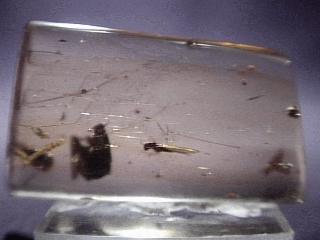
AMBER specimen amb-22
$ 65.00
$ 65.00
Dims: 1.7" x 1.1" x 0.4"(4.3 x 2.8 x 1.0 cm)
Wt: 8.4 g
Boyaca, Colombia
At least 10 14-million-year-old insect inclusions are trapped in this Columbian Amber specimen. They include 2 tiny spiders, a winged termite, a variety of flies, and a small bee. Their are also a few very long, very thin legs that are detached from their owner's body(probably a spider or caddis fly). I especially like the spiders-they are dwarfed by the rest of the insects, and one should use a loupe or strong magnifier to see them properly.

amb-22 ($ 65.00)
Boyaca, Colombia
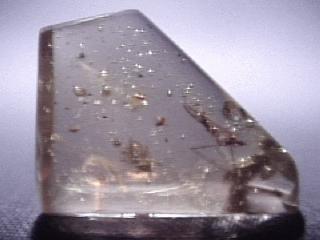
AMBER specimen amb-23
$ 80.00
$ 80.00
Dims: 1.2" x 0.9" x 0.5"(3.0 x 2.3 x 1.3 cm)
Wt: 4.0 g
Boyaca, Colombia
Several insects rest in this Amber specimen. It comes from Columbia, and dates back to the Miocene epoch(approx. 14 M.Y.A.) I think this specimen is quite impressive simply because it is the first that I have seen that contains a cockroach. Other insects include a few flies and a cranefly. There is also a bit of plant that is either a piece of moss or a tiny fern frond, I can't really tell which. However, if one examines this at about 30x magnification, one will see a line of pairs of tiny, symmetrical leaflets, one on each side of the stem; these leaflets have a scaly pattern on their surfaces. The detail is incredible; one needs at least 15x magnification just to define this pattern!

amb-23 ($ 80.00)
Boyaca, Colombia

AMBER specimen amb-24
$ 150.00
$ 150.00
Dims: 2.2" x 1.6" x 0.4" (5.6 x 4.1 x 1.0 cm)
Wt: 14.4 g
Boyaca, Colombia
One of the most impressive specimens of our selection, this 14-million-year-old piece of fossilized tree resin contains many insects, including an ant, several tiny flies, at least one dark beetle, two worker termites, two winged termites, and a small fern frond. The two winged termites are very large and easily visible. One of them is only half complete, but the other is in perfect condition, with all of its four wings visible and spread out like a fan. This insect alone makes the specimen one of our finest.
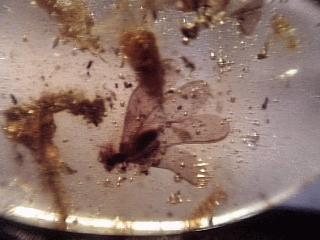

amb-24 ($150.00)
Boyaca, Colombia

$ 120.00
Dims: 2.6" x 2.2" x 1.1" (6.6 x 5.6 x 2.8 cm)
Wt: 1.36 oz. (38.5 g)
Sayersville, New Jersey, U.S.A.
Though this Amber specimen is very small and almost certainly does not contain any insect inclusions, it is nonetheless a very unusual specimen. Its locality, in the eastern state of New Jersey in the U.S., is a place that is all but unknown for its amber specimens. It has an intriguing tubular form and the standard yellow-gold color of amber. Its luster is dull, and it is translucent. There are odd internal fractures or lines visible in the cross-section that are concentric- I do not know what this means about its formation. It rests on a host rock of what appears to be a soft coal (lignite?), or maybe some type of natural charcoal or other carbon-dominant material. It is one of the oddest specimens that we have found, and I doubt that we will be able to get another from this area.

Sayersville, New Jersey, U.S.A.
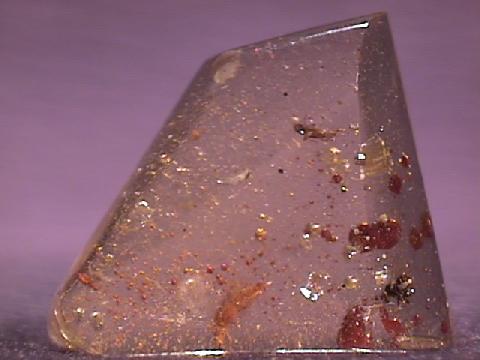
AMBER specimen amb-27
$ 60.00
$ 60.00
Dims: 1.0 x 0.9 x 0.3" (2.5 x 2.3 x 0.8 cm)
Wt: 3.3 g
Boyaca, Colombia
This small Amber specimen from the prolific Boyaca locality has been dated to the Miocene epoch, and is about 14 million years old. It is relatively clear, and has many inclusions, including a Staphilinid beetle, a small leafhopper, a tiny spider, at least one fly (see the close-up image), and what appear to be several eggs or seed-pods that have a deep orange coloration. Examination with a loupe and bright back-lighting will show that many of the smaller pods contain movable air bubbles, denoting two-phase inclusions.
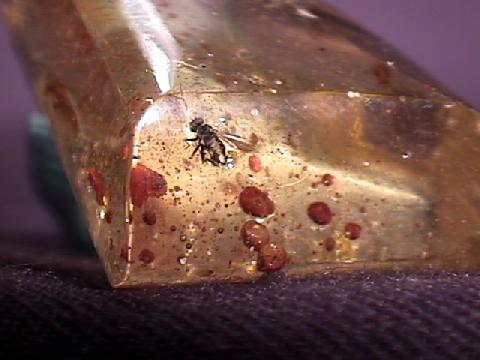

amb-27 ($ 60.00)
Boyaca, Colombia
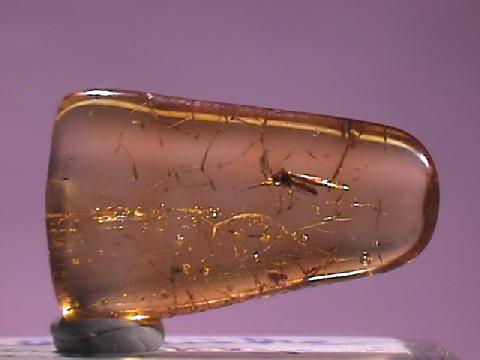
AMBER specimen amb-28
$ 25.00
$ 25.00
Dims: 0.6 x 0.4 x 0.1" (1.5 x 1.0 x 0.3 cm)
Wt: 6.3 g with viewing box
Yantavi Mine, Kalilingrad, Baltic region, Russia
This very small and simple specimen consists of a piece of polished amber that contains several air bubbles and a tiny, well-preserved midge. According to the documentation, this particular species of midge is of a variety that does not bite. I examined this insect under 10-power magnification, and though one could easily mistake it for a mosquito, I am inclined to agree that it is not one. A round stress fracture is aligned perfectly with the insect's wings, but when viewed under magnification at the correct angle, one can see that they are intact, spread, and beautifully detailed. It is affixed inside a plastic box with a magnifying lid.

amb-28 ($ 25.00)
Yantavi Mine, Kalilingrad, Baltic region, Russia
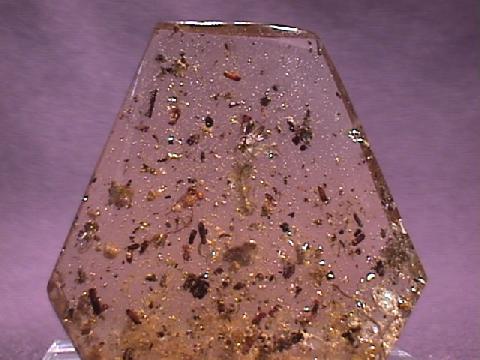
AMBER specimen amb-29
$ 140.00
$ 140.00
Dims: 1.8 x 1.7 x 0.4" (4.6 x 4.3 x 1.0 cm)
Wt: 10.6 g
Boyaca, Colombia
This excellent piece of amber is relatively flat and has a rather regular, almost hexagonal shape. It is completely polished and contains many inclusions, including a small cricket, dozens of tiny ambrosia beetles, several tiny flies, at least 2 spiders, a few mosquitos, and finally a small piece of moss (see the close-up image). And if that were not enough, there are also several bubbles that contain visible, moving air bubbles, denoting 2-phase inclusions!
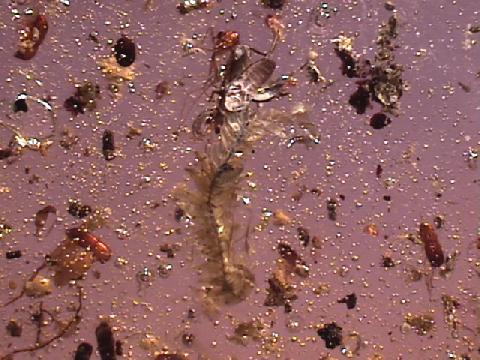

amb-29 ($140.00)
Boyaca, Colombia

AMBER specimen amb-30
$ 38.00
$ 38.00
Dims: 3.0 x 2.0 x 1.3" (7.6 x 5.1 x 3.3 cm)
Wt: 1.40 oz. (39.8 g)
Santander, Colombia
This rather large Amber specimen comes from the prolific Colombian locality of Santander. Only one flat face has been ground into the specimen and polished; the remainder of its surface area has been kept in its original shape and state. Though there ar no visible insects in this specimen, it is special in the fact that it has almost no inclusions whatsoever, and thus has exceptional clarity. The polished surface enables one to see an unearthly "landscape" formed by its natural shape, complete with tubelike tunnels that extend into the Amber. One of these does not pass completely through the material, and reminds me of a snake rearing its head (see the close-up image). It is a very beautiful specimen.
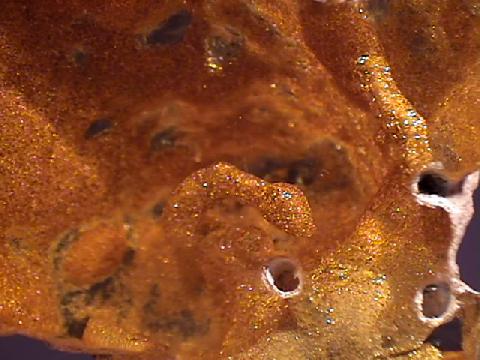

amb-30 ($ 38.00)
Santander, Colombia
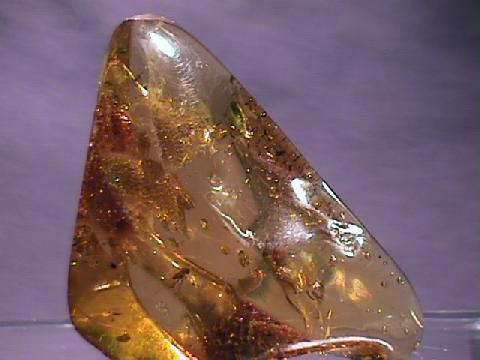
AMBER specimen amb-31
$ 45.00
$ 45.00
Dims: 1.6 x 1.0 x 0.5" (4.1 x 2.5 x 1.3 cm)
Wt: 5.0 g
Yantavi Mine, Kalilingrad, Baltic area, Russia
This specimen consists of a small, amorphous piece of polished Baltic Amber that has only a few inclusions. One of these is a small fly, complete with spread wings, that shows relatively good detail. There do not appear to be any other insect inclusions, but there are several air or water bubbles, and a tunnel extending through the piece that was probably caused by a piece of wood. Oddly, whatever caused the tunnel mouldered away, and it was subsequently partially filled with more amber! Thus, a large portion of the tunnel appears to be quite clear and transparent (see the close-up image), while the surfaces near its openings are much dirtier and difficult to see through.
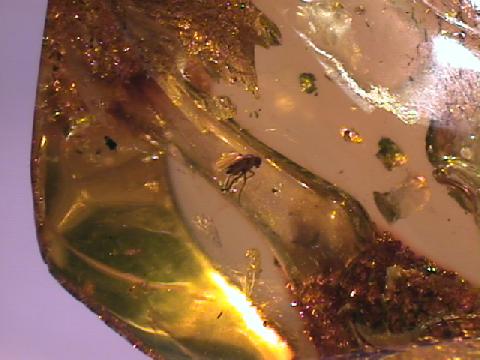

amb-31 ($ 45.00)
Yantavi Mine, Kalilingrad, Baltic area, Russia
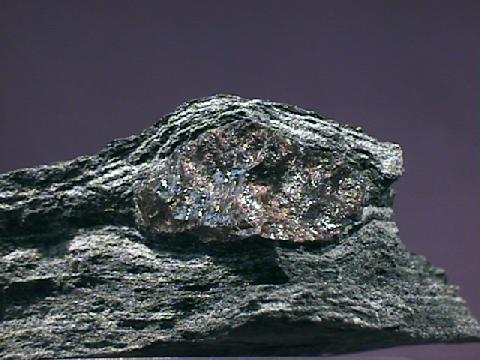
AMBER specimen amb-33
$ 40.00
$ 40.00
Dims: 2.5 x 1.6 x 0.5" (6.4 x 4.1 x 1.3 cm)
Wt: 17.1 g
near Golling, Austria
This odd specimen consists of a matrix of a black, layered sedimentary rock in which are trapped at least 3 incomplete Amber nodules. It is quite difficult to determine the Amber's proper color and nearly impossible to determine its translucence/transparence or whether it contains any inclusions, as most of each nodule is embedded. Their exposed, broken surfaces show a pearly luster, and they do show a hint of the classic brownish-gold color that one expects of Amber. The host rock looks very much like a variety of coal, but shows paler, gray banding among its layers.
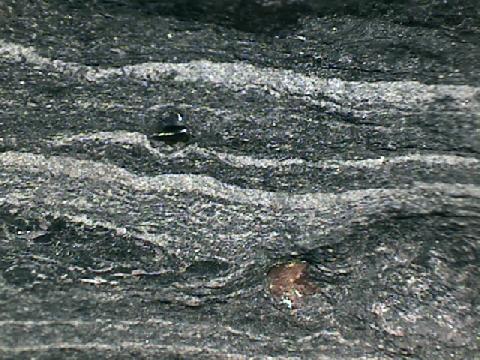

amb-33 ($ 40.00)
near Golling, Austria
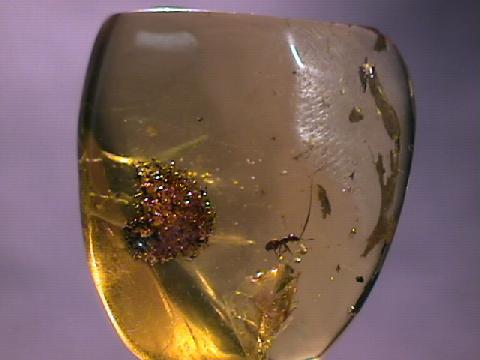
AMBER specimen amb-34
$ 45.00
$ 45.00
Dims: 1.3 x 1.1 x 0.4" (3.3 x 2.8 x 1.0 cm)
Wt: 5.9 g
Yantavi Mine, Kalilingrad, Baltic area, Russia
This polished Amber specimen has several inclusions, only one of which is really noticeable without magnification. That particular inclusion is a single ant that is very well-preserved with all of its legs and antennae present and intact, though magnification is needed to confirm this. It measures about 3-4 mm in length. Just under the surface on the opposite side are several tiny air bubbles. These do not more than 1 mm in diameter, so one must use at least 10-power magnification to see that some of them contain 2-phase inclusions, denoted by air bubbles trapped within.
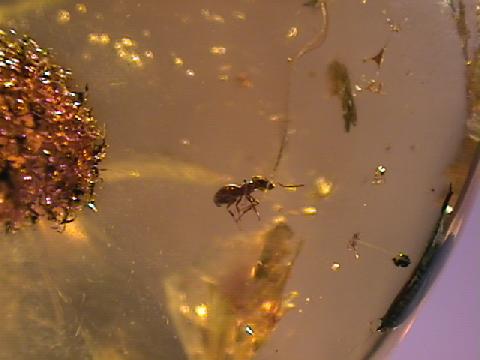

amb-34 ($ 45.00)
Yantavi Mine, Kalilingrad, Baltic area, Russia

AMBER specimen amb-35
$ 65.00
$ 65.00
Dims: 1.0 x 0.7 x 0.4" (2.5 x 1.8 x 1.0 cm)
Wt: 2.5 g
Yantavi Mine, Kalilingrad, Baltic area, Russia
Another small polished piece, this specimen contains a several inclusions, including a spider and at least 2 small insects that my documentation says are cicadalana. I can only guess that these are a tiny relative of the modern cicada. All of the insects are bisected by internal tension fractures that formed around them. There are a few other small inclusions, but none of any interesting content.
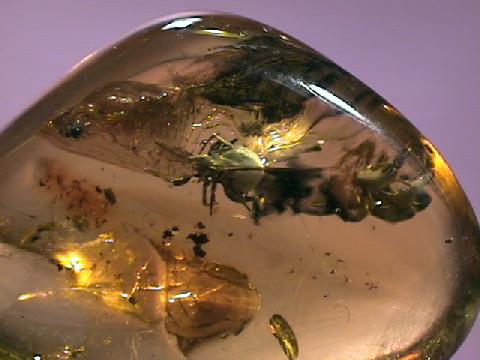

amb-35 ($ 65.00)
Yantavi Mine, Kalilingrad, Baltic area, Russia
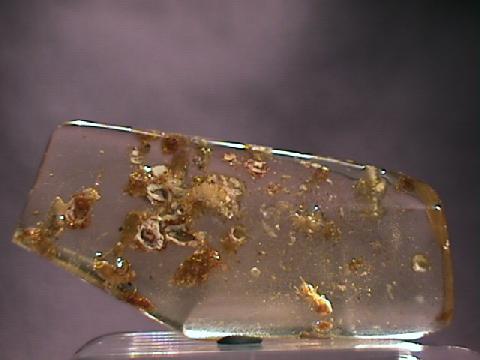
AMBER specimen amb-36
$ 80.00
$ 80.00
Dims: 1.0 x 0.7 x 0.4" (2.5 x 1.8 x 1.0 cm)
Wt: 2.5 g
Boyaca, Colombia
This polished piece of shapeless Amber was formed during the Miocene Epoch (about 14 million years ago) and contains many insect inclusions, including many worker termites, one of which has a tiny mite walking on its antenna (see the close-up image, right side, right-hand antenna) that our image does not clearly show. There are also several small bits of white fungus and several air bubbles. Some of these air bubbles are noticeable inside the heads and bodies of some of the termites, and denote 2-phase inclusions.
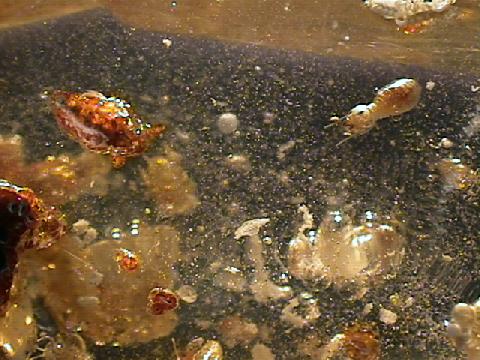

amb-36 ($ 80.00)
Boyaca, Colombia
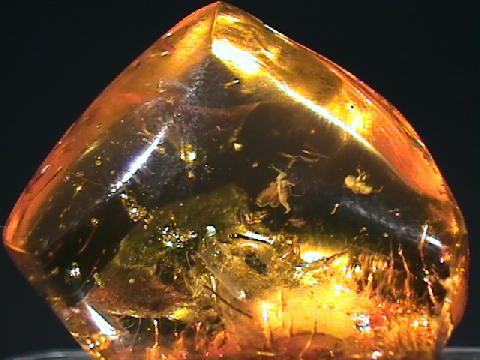
AMBER specimen amb-37
$ 90.00
$ 90.00
Dims: 1.2 x 1.1 x 0.6" (3.0 x 2.8 x 1.5 cm)
Wt: 7.2 g
Yantavi Mine, Kalilingrad, Baltic area, Russia
This small polished Baltic Amber piece has some rather large internal fractures within. However, only one of the four insects trapped inside are difficult to see because of it. The most noticeable of the four is a small fly that is extremely well-preserved. Under 10-power magnification, one can easily see the veins in its wings and the knobby sections of its antennae. Less than 1 cm away rests an ant that also shows some detail, though not as much as the fly. The last two insects are more or less entangled and are just under 1 cm away from the fly. At least one appears to also be some type of winged insect, but it is very odd- examination with a 10-power loupe shows that its antennae appear to be "fuzzy", like those of a moth! I do not believe that it is a moth, though, as its body is not nearly stocky enough, and it does not have large, opaque wings. I am pretty certain that it is some type of wasp or carnivorous fly that was trapped as it caught and dined on a smaller insect, and then a fungus started to attack its head, making it appear "hairy".


amb-37 ($ 90.00)
Yantavi Mine, Kalilingrad, Baltic area, Russia
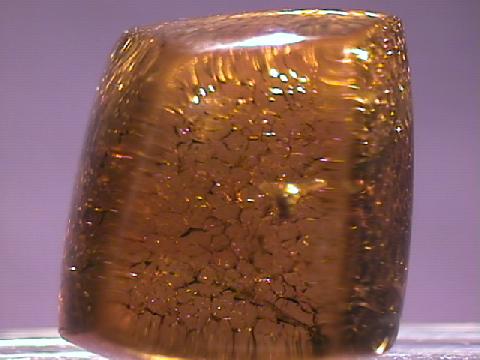
AMBER specimen amb-38
$ 60.00
$ 60.00
Dims: 0.8 x 0.7 x 0.7" (2.0 x 1.8 x 1.8 cm)
Wt: 5.6 g
Yantavi Mine, Kalilingrad, Baltic area, Russia
A rather small, almost cubic piece of polished amber makes up this specimen. The cutter did not completely grind down one face before polishing, so that it is not quite transparent. This actually enhances the total visual effect of the piece, as suspended above this "surface" is a single fly that appears frozen in mid-flight. Close examination with a 10-power loupe shows that it is excellently-preserved; the veins on its wings and the spikes on its legs are easily visible. There is a noticeable warping and lack of detail on the fly's back, though, as 2 or 3 air bubbles are stuck there. It almost appears that the fly was going to go "diving", with a supply of air stuck to its back!


amb-38 ($ 60.00)
Yantavi Mine, Kalilingrad, Baltic area, Russia
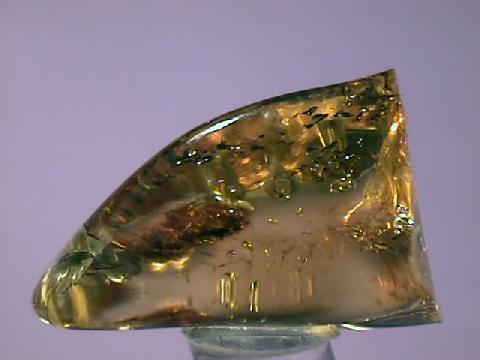
AMBER specimen amb-39
$ 25.00
$ 25.00
Dims: 0.8 x 0.5 x 0.4" (2.0 x 1.3 x 1.0 cm)
Wt: 1.0 g
Yantavi Mine, Kalilingrad, Baltic area, Russia
This miniscule specimen consists of a completely polished piece of Amber. It has a moderate golden color and is transparent and quite clear. It contains several inclusions, one of which is a small beetle that is surrounded by 3 internal tension fissures. These fissures make it rather difficult to effectively study the insect, but there is still considerable visible detail under magnification. There are also many air bubbles trapped within; some of these contain other bubbles, denoting two-phase inclusions. It is affixed with a putty to the interior of a small specimen box with a magnifying lid.

amb-39 ($ 25.00)
Yantavi Mine, Kalilingrad, Baltic area, Russia
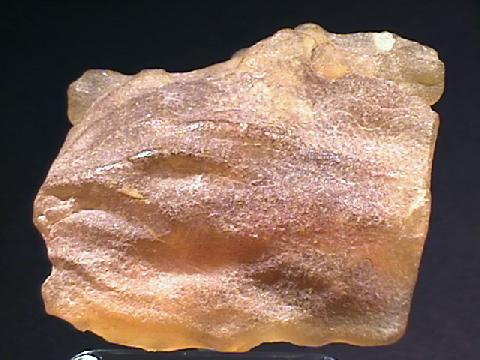
AMBER specimen amb-40
$ 47.00
$ 47.00
Dims: 3.0 x 2.5 x 1.4" (7.6 x 6.4 x 3.6 cm)
Wt: 2.00 oz. (56.9 g)
Yantavi Mine, Kalilingrad, Baltic area, Russia
A rather large, unpolished chunk of Amber makes up this hand specimen. It is in excellent condition, showing almost none of the vitreous luster and conchoidal texture that denotes any damage. Instead, its surfaces are rounded and worn to a dull waxy or resinous luster. It has a moderate golden color and is transparent, though one cannot determine its clarity due to its weathered finish. This also prevents one from determining the presence or types of inclusions that may be inside! One could easily cut a face into the piece or start to polish an area with an emery cloth or buff pad.
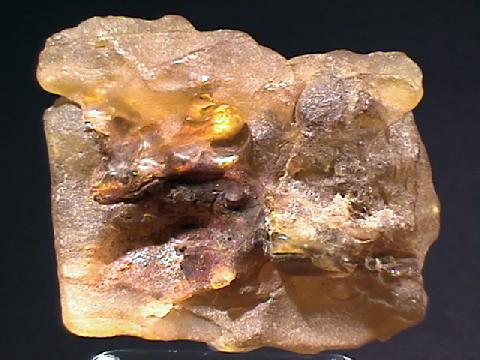

amb-40 ($ 47.00)
Yantavi Mine, Kalilingrad, Baltic area, Russia
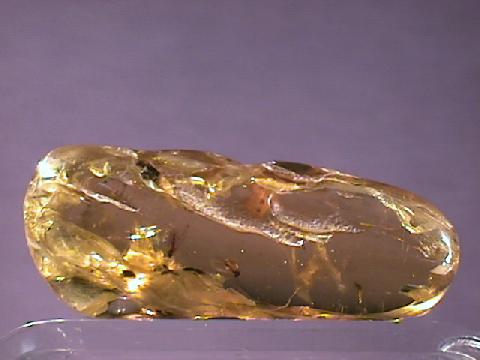
AMBER specimen amb-41
$ 65.00
$ 65.00
Dims: 1.8 x 0.7 x 0.4" (4.6 x 1.8 x 1.0 cm)
Wt: 4.4 g
Yantavi Mine, Kalilingrad, Baltic area, Russia
This small polished piece of Baltic Amber has a relatively pale yellow color and is transparent and quite clear. It contains a variety of inclusions, three of which are insectoidal. These three insects are all of a variety of fungus gnat that one might mistake for mosquitos. All appear to be in excellent condition, though two of them are much more expoosed and easier to see than the third. Under 15-power magnification, one can just make out the patterns made by the veins in their wings, and their legs are clearly visible.


amb-41 ($ 65.00)
Yantavi Mine, Kalilingrad, Baltic area, Russia
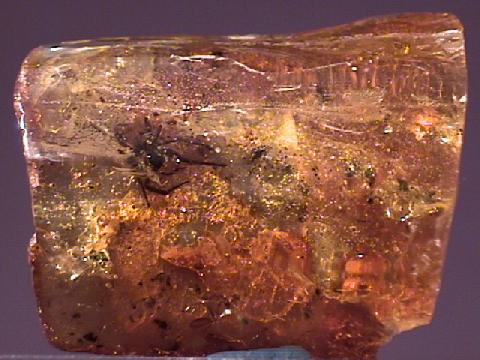
AMBER specimen amb-42
$ 70.00
$ 70.00
Dims: 1.1 x 0.9 x 0.4" (2.8 x 2.3 x 1.0 cm)
Wt: 3.3 g
Yantavi Mine, Kalilingrad, Baltic area, Russia
A very small Amber specimen, this piece is flat and has one polished side so that its interior can be seen. It has a moderate golden coloration and a pearly-to-waxy luster on its unpolished surface. There are many inclusions trapped inside of it; the most noticeable is a large spider that may be missing a leg, but is still in excellent condition. There are also 2 flies that I believe are of the genus Avaneida- these are more difficult to see, and magnification must be used to study them properly. There are also a myriad of black carbon inclusions and a few visible bubbles. Two of these tiny bubbles contain bubbles of their own, denoting two-phase inclusions.
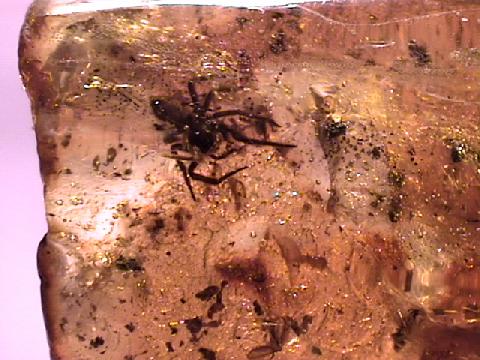

amb-42 ($ 70.00)
Yantavi Mine, Kalilingrad, Baltic area, Russia
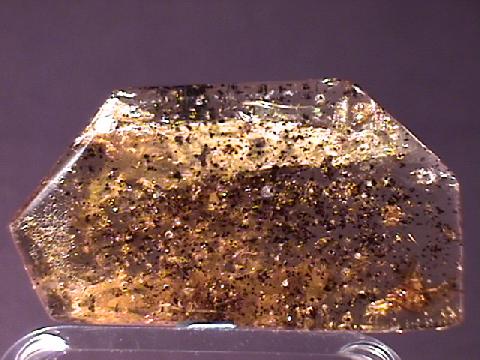
AMBER specimen amb-43
$ 65.00
$ 65.00
Dims: 2.3 x 1.4 x 0.4" (5.8 x 3.6 x 1.0 cm)
Wt: 13.1 g
Boyaca, Colombia
This sizable piece of polished Colombian Amber is so full of various inclusions that it is very difficult to pick out the insects, even under magnification! However, there are several insects waiting to be studied, including at least 2 flies, 2 spiders, and what appears to be part of a wasp. There are also some very large, white inclusions that I thought at first were internal fractures. However, under magnification, I noticed that they showed very strange patterns around their edges that I might associate with the properties of a fluid! I have never seen an inclusion like it before.

amb-43 ($ 65.00)
Boyaca, Colombia
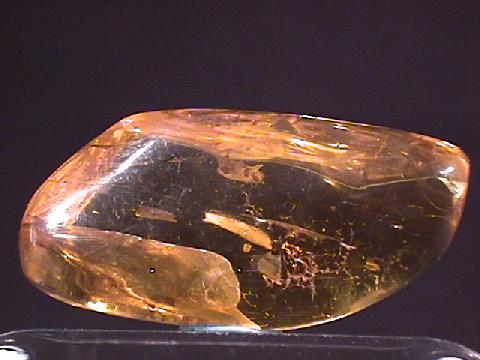
AMBER specimen amb-44
$ 60.00
$ 60.00
Dims: 1.6 x 0.8 x 0.5" (4.1 x 2.0 x 1.3 cm)
Wt: 7.0 g
Yantavi Mine, Kalilingrad, Baltic area, Russia
This small piece of polished Baltic Amber has the classic pale golden color and the bright, resinous luster that one expects from this material. It is transparent and relatively clear, though there are several internal fractures and round tension fissures clearly visible. There are also several inclusions, the most notable being a tiny spider (see the close-up image).
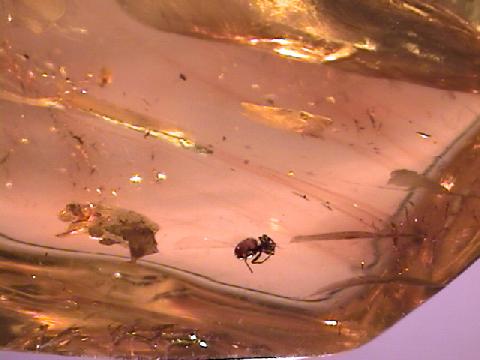

amb-44 ($ 60.00)
Yantavi Mine, Kalilingrad, Baltic area, Russia
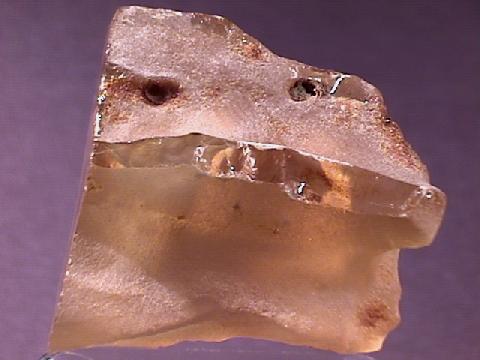
AMBER specimen amb-45
$ 35.00
$ 35.00
Dims: 2.0 x 2.0 x 1.4" (5.1 x 5.1 x 3.6 cm)
Wt: 1.23 oz. (34.9 g)
Santander, Colombia
Though this large Colombian Amber specimen shows considerable damage, it is a joy to look at! It consists of a piece of rough material that was connected to another, possibly larger piece by a long, narrow strip of material that was the breaking point between the two. This breakage has left a long, thin surface with a conchoidal fracture and a bright, resinous luster. Elsewhere on the specimen a flat face was ground into it and polished so that one could see into the Amber. The rest of the specimen's surface has the dull, matte appearance of rough Amber, providing a good texture so that one can accurately gauge its shape from its interior, as well. When viewing the piece's interior, one immediately will notice the "pipe" that extends through it (see the close-up image). There are a few small, unidentifiable inclusions trapped behind the pipe, but it is this small tunnel that extends completely through the piece that make it really interesting.
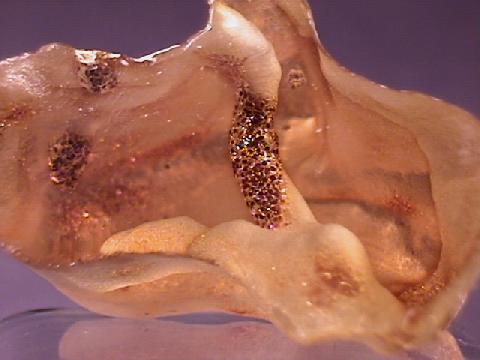

amb-45 ($ 35.00)
Santander, Colombia
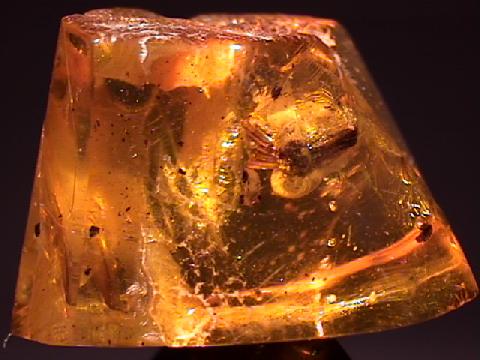
AMBER specimen amb-46
$ 80.00
$ 80.00
Dims: 0.9 x 0.6 x 0.6" (2.3 x 1.5 x 1.5 cm)
Wt: 3.3 g
Yantavi Mine, Kalilingrad, Baltic area, Russia
This small polished Amber specimen is special in that it contains a very well-preserved spider. It would appear that this is the only complete insectoidal inclusion that this piece contains. There are several other inclusions, but these are much smaller and cannot be identified. There is one small face on the semi-conical specimen that is not polished; all of the rest show an even, resinous luster. It has a moderate golden color, and is transparent and quite clear, though it contains several large internal fractures.
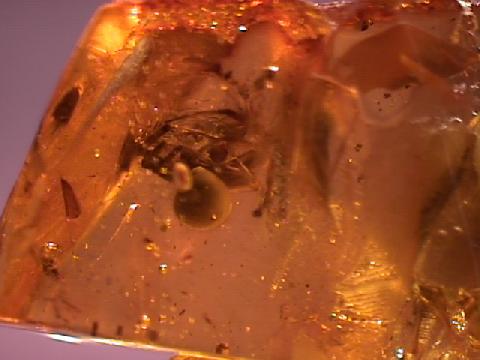

amb-46 ($ 80.00)
Yantavi Mine, Kalilingrad, Baltic area, Russia
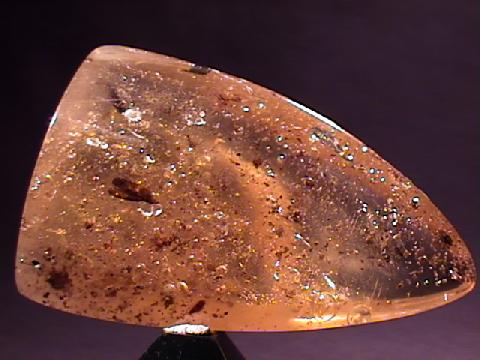
AMBER specimen amb-47
$ 90.00
$ 90.00
Dims: 2.1 x 1.3 x 0.7" (5.3 x 3.3 x 1.8 cm)
Wt: 16.5 g
Boyaca, Colombia
This specimen consists a thumb-sized piece of polished Amber. It has a bright, resinous luster and a moderately pale yellow color, and is transparent. It is not very clear, however, because it contains scores of inclusions, some of which are insectoidal. There is a well-preserved spider, 2 beetles, at least 4 flies, an ant and an incomplete wasp, along with many nondescript inclusions and several air bubbles. Some of these bubbles have an oddly flattened shape, as if the air or water that they contained was partly drained out.
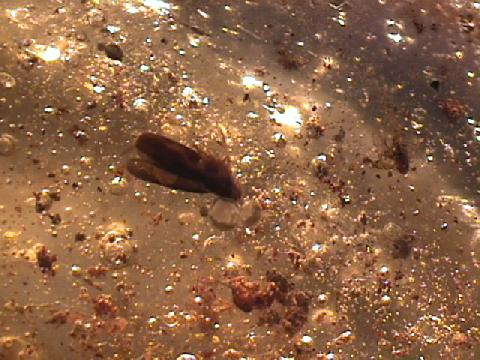

amb-47 ($ 90.00)
Boyaca, Colombia
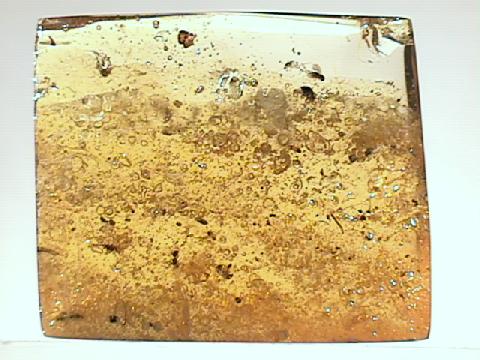
AMBER specimen amb-48
$ 70.00
$ 70.00
Dims: 1.6 x 1.4 x 0.4" (4.1 x 3.6 x 1.0 cm)
Wt: 14.1 g
Boyaca, Colombia
This polished amber piece most likely came from an ancient rain forest and is dated back to the Miocene epoch, approximately 14 million years ago. The Amber has a pale golden color and is transparent and moderately clear, as it contains many inclusions. These consist of a beetle, a small wasp, several tiny flies, a single ant, at least one tiny mosquito, and many small water inclusions, a few of which are two-phased.


amb-48 ($ 70.00)
Boyaca, Colombia
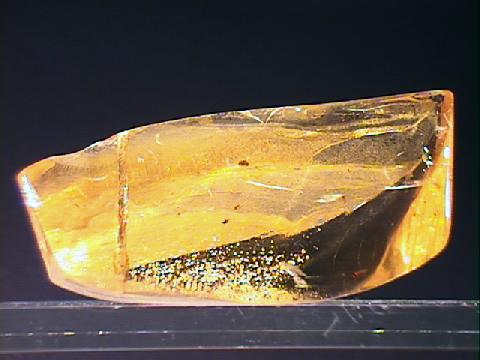
AMBER specimen amb-49
$ 100.00
$ 100.00
Dims: 2.7 x 1.1 x 0.9" (6.8 x 2.9 x 2.4 cm)
Wt: 8.9 g
100 km south of Mombasa, Kenya
This hand specimen consists of a mostly-polished piece of Amber that contains several inclusions. There are several tiny mosquitoes, at least 2 different species of fly, one of which strongly resembles the common fruit fly of today, a small and beautifully-preserved beetle with a subtle pebbly patterning on its shell, a section of a twig, and many air bubbles.
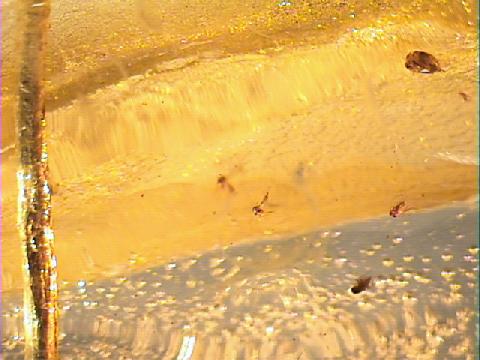

amb-49 ($100.00)
100 km south of Mombasa, Kenya

AMBER specimen amb-50
$ 75.00
$ 75.00
Dims: 3.5 x 2.8 x 1.0" (8.8 x 7.0 x 2.4 cm)
Wt: 1.64 oz. (46.6 g)
Santander, Colombia
This cut and partly polished Amber specimen has the standard golden color and matte luster on its uncut surfaces, and is transparent and quite clear. The flat, polished face enables one to see many small inclusions within, including a single termite, many air bubbles, and what are probably scores of tiny eggs. When viewed under at least 10-power magnification, one can see movable air bubbles within these "eggs", denoting two-phase inclusions. There are also what appear to be two patches of a white mold or fungus, one of which likely attacked the decaying body of the termite.
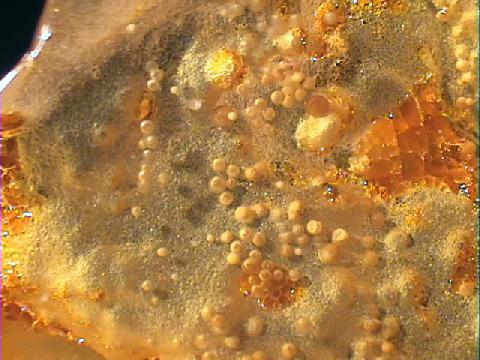

amb-50 ($ 75.00)
Santander, Colombia
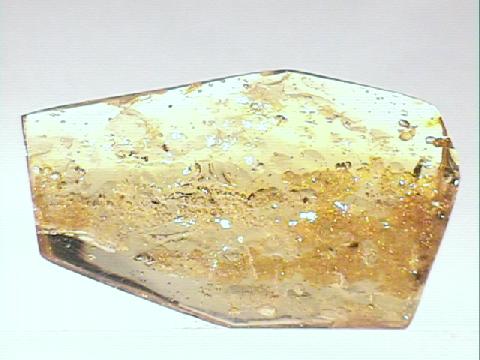
AMBER specimen amb-51
$ 60.00
$ 60.00
Dims: 2.5 x 1.6 x 0.5" (6.4 x 4.1 x 1.3 cm)
Wt: 17.1 g
Boyaca, Colombia
This hand specimen consists of a flat, polished piece of Amber that is in good condition and has a pale golden color. It is transparent but only dimly to moderately clear due to its many inclusions and round tension fissures. Besides scores of air bubbles, it contains a few different species of flies, a tiny beetle, and an equally tiny wasp, along with what appear to be a few scattered seed casings that are nearly microscopic in size.
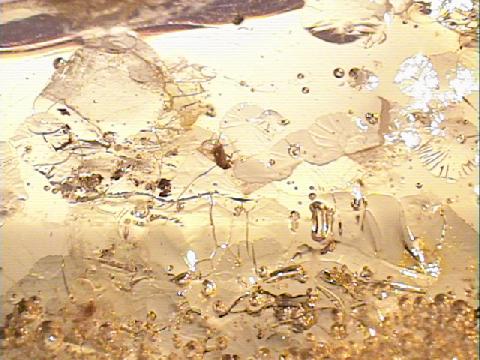

amb-51 ($ 60.00)
Boyaca, Colombia
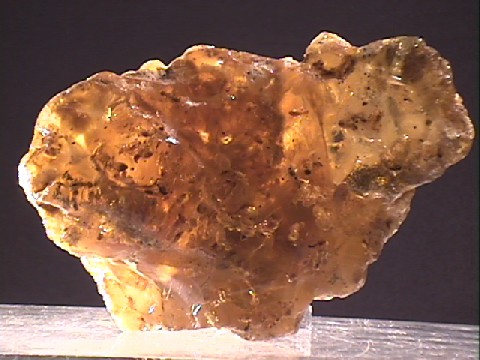
AMBER specimen amb-52
$ 250.00
$ 250.00
Dims: 4.0 x 2.7 x 1.6" (10.1 x 6.9 x 4.2 cm)
Wt: 4.16 oz. (117.9 g)
Santander, Colombia
This large hand specimen consists of a chunk of partly-polished Amber that has a golden color and a greasy luster. It is transparent and moderately clear, but contains many inclusions. At least 30 of these are in the form of worker termites that show excellent detail- a few of the termite inclusions contain air bubbles that denote two-phase inclusions. There are also several inclusions that appear to be made up of a white fungus, along with one very large inclusion that is surrounded by the fungus- it might be that of one or more very large insects, though I cannot be sure.


amb-52 ($250.00)
Santander, Colombia
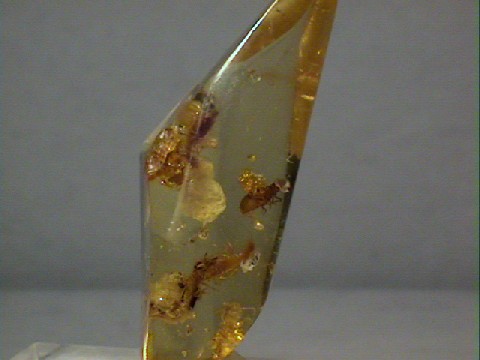
AMBER specimen amb-53
$ 60.00
$ 60.00
Dims:1.2x0.6x0.5" (3.0x1.5x1.3 cm)
Wt: 0.1oz. (2g)
Boyaca, Columbia
This specimen consists of a piece of fully polished, light honey colored amber. I count 4 complete worker termites enclosed within the amber, as well as a bit of what appears to be some type of fungus. This specimen is of Miocene age-approximately 14 million years old.
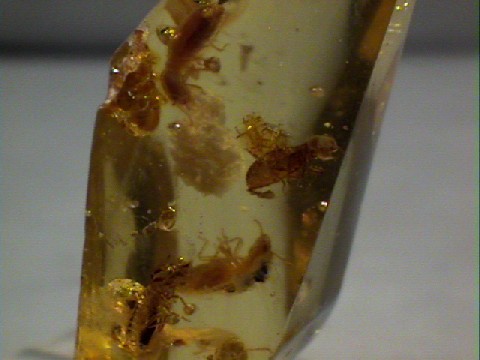

amb-53 ($ 60.00)
Boyaca, Columbia
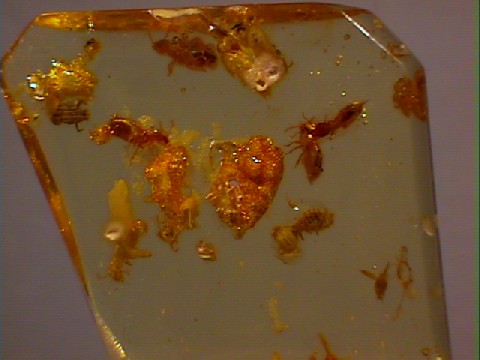
AMBER specimen amb-54
$ 90.00
$ 90.00
Dims:1.4x1.3x0.2" (3.6x3.3x0.5 cm)
Wt: 0.1oz. (4g)
Boyaca, Columbia
This specimen consists of a fully polished piece of light honey colored amber. There are at least 9 worker termites in this piece, as well as a fly and a darkling beetle. This specimen is of miocene age-approximately 14 million years old.
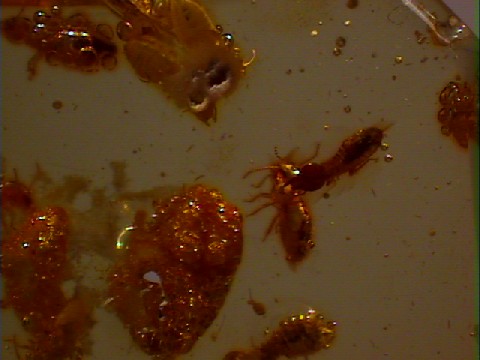

amb-54 ($ 90.00)
Boyaca, Columbia
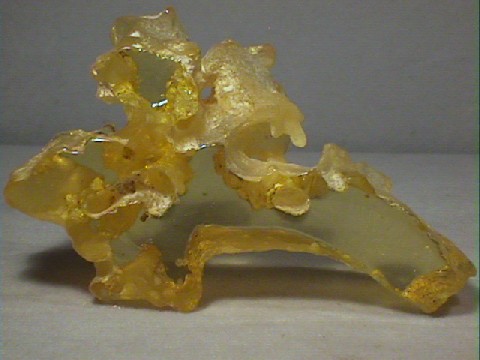
AMBER specimen amb-55
$ 25.00
$ 25.00
Dims:2.4x1.4x0.8" (6.1x3.6x2.0 cm)
Wt: 0.5oz. (14g)
Boyaca, Columbia
This specimen consists of an irregularly shaped piece of amber polished on two sides. The color is that of a light honey. I could find no insects or other foreign material in this specimen. The only inclusions appear to be a couple of small air bubbles. This specimen is of miocene age-approximately 14 million years old.

amb-55 ($ 25.00)
Boyaca, Columbia
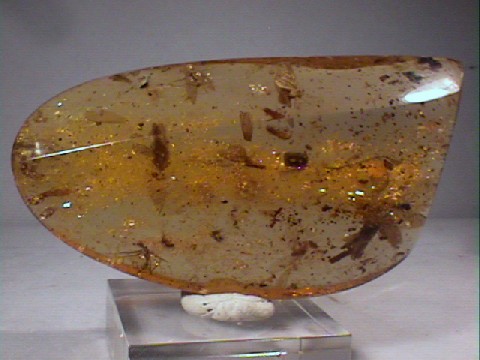
AMBER specimen amb-56
$ 225.00
$ 225.00
Dims:3.0x1.7x0.6" (7.6x4.3x1.5 cm)
Wt: 1.1oz. (30g)
Boyaca, Columbia
This specimen consists of a fully polished piece of light honey colored amber. This piece is a veritable gold mine of inclusions. I found a leafhopper, winged termites, silverfish, flies, and many small ants trapped within this piece. This specimen is of miocene age-approximately 14 million years old.
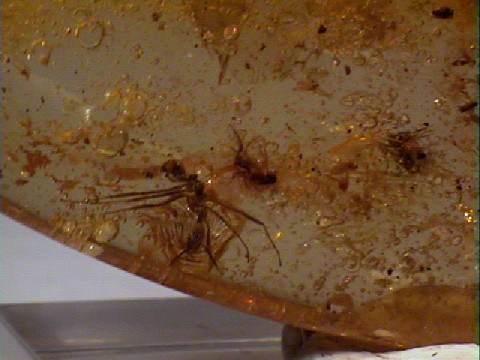

amb-56 ($225.00)
Boyaca, Columbia
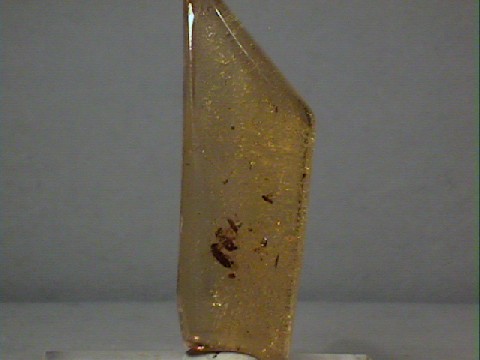
AMBER specimen amb-57
$ 45.00
$ 45.00
Dims:1.5x0.6x0.4" (3.8x1.5x1.0 cm)
Wt: 0.1oz. (4g)
Boyaca, Columbia
This specimen consists of a fully polished piece of light honey colored amber. Under a loupe, I found three beetles, and two flies included in the amber. This specimen would be very suitable for wirewrapping so that it could be worn as a necklace. This specimen is of miocene age-approximately 14 million years old.

amb-57 ($ 45.00)
Boyaca, Columbia
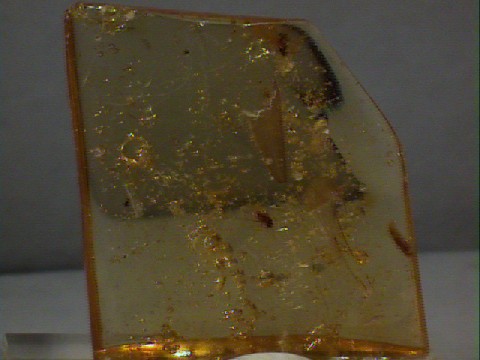
AMBER specimen amb-58
$ 60.00
$ 60.00
Dims:1.1x1.1x0.2" (2.8x2.8x0.5 cm)
Wt: 0.1oz. (3g)
Boyaca, Columbia
This specimen consists of a fully polished piece of light honey colored amber. Included within this specimen are two flies and a fairly large wing from some insect-possibly from a winged termite. This piece is of miocene age-approximately 14 million years old.
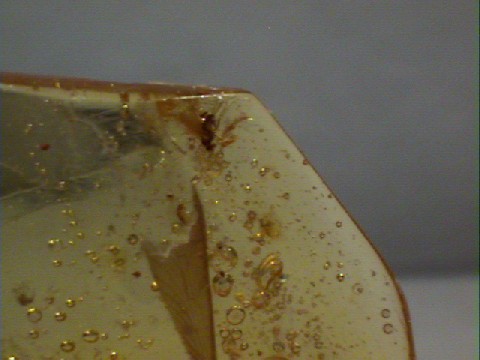

amb-58 ($ 60.00)
Boyaca, Columbia
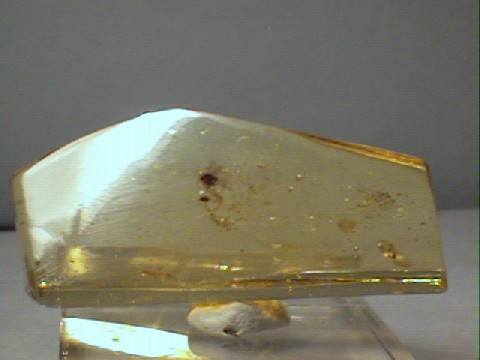
AMBER specimen amb-59
$ 60.00
$ 60.00
Dims:2.0x0.9x0.4" (5.1x2.3x1.0 cm)
Wt: 0.2oz. (6g)
Boyaca, Columbia
This specimen consists of a fully polished piece of light honey colored amber.Included in this piece of amber I found the following insects: fly, a beetle, and what appears to be a leafhopper. Also, there are raindrops included in this specimen. These are fascinating to examine under a loupe. This specimen is also of miocene age-approximately 14 million years old.


amb-59 ($ 60.00)
Boyaca, Columbia
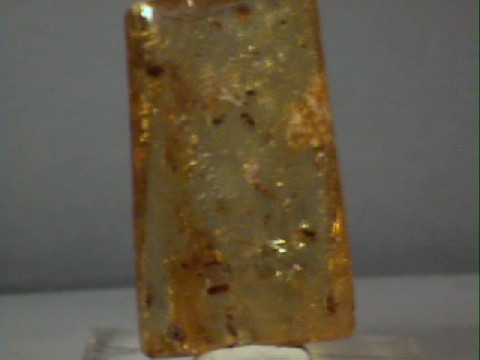
AMBER specimen amb-60
$ 60.00
$ 60.00
Dims:1.6x0.9x0.2" (4.1x2.3x0.5 cm)
Wt: 0.2oz. (5g)
Boyaca, Columbia
This is a fully polished specimen of light honey colored amber. Included within this piece are an ant, at least five flies, and a beetle. This specimen is of miocene age-approximately 14 million years old.


amb-60 ($ 60.00)
Boyaca, Columbia
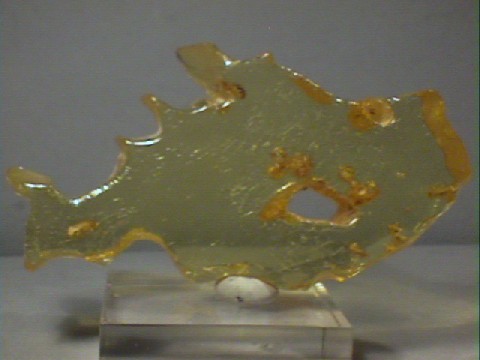
AMBER specimen amb-61
$ 30.00
$ 30.00
Dims:2.9x1.6x0.4" (7.4x4.1x1.0 cm)
Wt: 0.7oz. (19g)
Boyaca, Columbia
This is an irregularly shaped piece of light honey colored amber that has been polished on two sides. Included within the amber are what appears to be a couple of worker termites. This piece is of miocene age-approximately 14 million years old.

amb-61 ($ 30.00)
Boyaca, Columbia
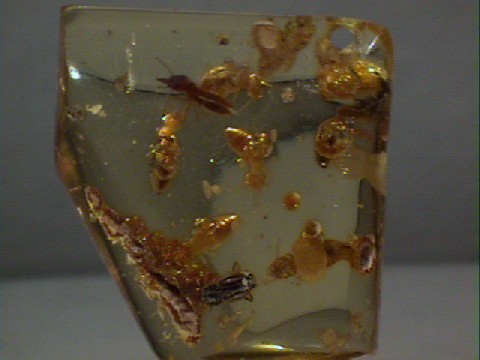
AMBER specimen amb-62
$ 90.00
$ 90.00
Dims:0.8x0.8x0.3" (2.0x2.0x0.8 cm)
Wt: 0.1oz. (3g)
Boyaca, Columbia
This particular specimen of amber is fully polished, and is also of the light honey color that typifies Columbian amber. Included within this specimen are a warrior termite, several worker termites and a darkling beetle. This specimen is of miocene age-approximately 14 million years old.


amb-62 ($ 90.00)
Boyaca, Columbia
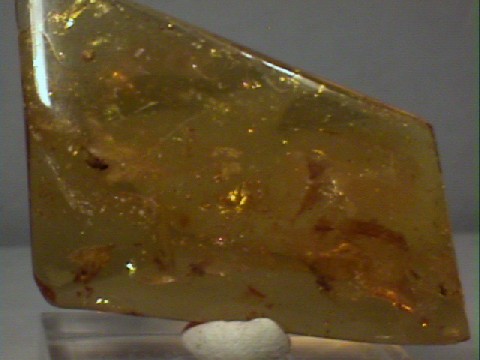
AMBER specimen amb-63
$ 90.00
$ 90.00
Dims:2.2x1.4x0.3" (5.6x3.6x0.8 cm)
Wt: 0.3oz. (9g)
Boyaca, Columbia
This is a fully polished specimen of columbian amber, and is of a light honey color. There are two flies included in this piece. One corner of the amber has a tiny chip missing; however this is only noticable with close scrutiny. This specimen also is of miocene age-approximately 14 million years old.


amb-63 ($ 90.00)
Boyaca, Columbia
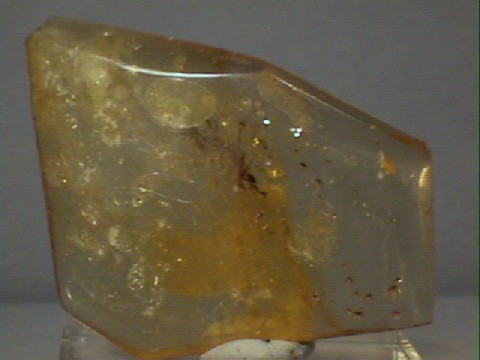
AMBER specimen amb-64
$ 45.00
$ 45.00
Dims:1.6x1.5x0.3" (4.1x3.8x0.8 cm)
Wt: 0.2oz. (7g)
Boyaca, Columbia
This is a fully polished specimen of amber, of a light honey color. Included in this piece is what appears to be either a male mosquito or an adult cranefly-even with a loupe, I cannot be certain. This amber is of miocene age-approximately 14 million years old.


amb-64 ($ 45.00)
Boyaca, Columbia
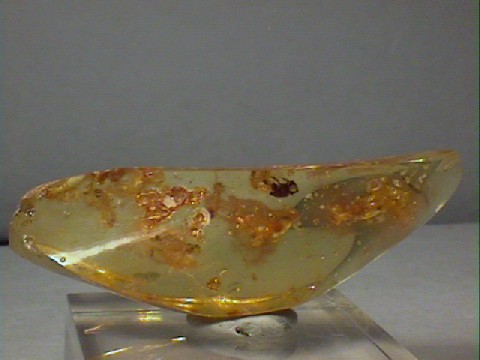
AMBER specimen amb-65
$ 60.00
$ 60.00
Dims:2.2x0.8x0.5" (5.6x2.0x1.3 cm)
Wt: 0.2oz. (7g)
Boyaca, Columbia
This is yet another piece of fully polished Columbian amber, of a light honey color. Within this piece are a darkling beetle, a bit of fungus, four complete termites, and a partial termite. This amber is of miocene age-approximately 14 million years old.
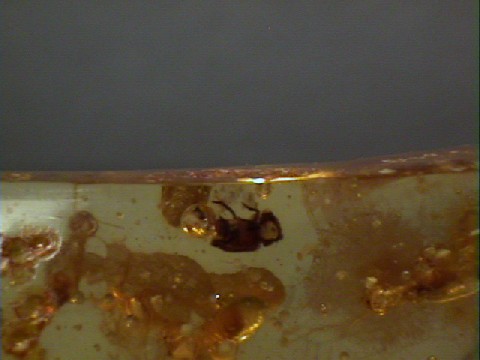

amb-65 ($ 60.00)
Boyaca, Columbia
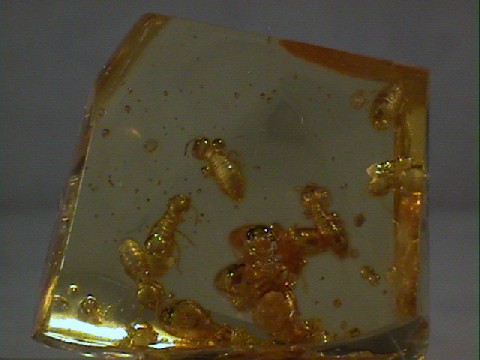
AMBER specimen amb-66
$ 60.00
$ 60.00
Dims:0.9x0.8x0.4" (2.3x2.0x1.0 cm)
Wt: 0.1oz. (4g)
Boyaca, Columbia
This specimen consists of a fully polished light honey colored piece of Columbian amber. Included within this material are several worker termites, a bit of fungus, and a couple of objects I believe to be termite eggs. This piece is of miocene age-approximately 14 million years old.
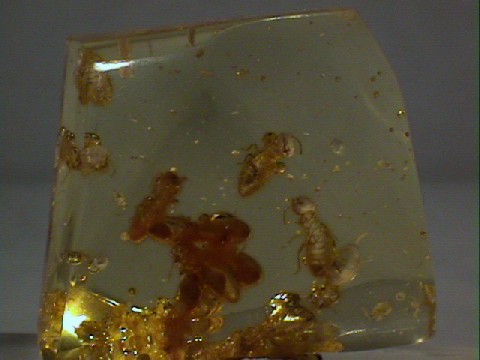

amb-66 ($ 60.00)
Boyaca, Columbia

AMBER specimen amb-67
$ 45.00
$ 45.00
Dims:1.6x1.0x0.6" (4.1x2.5x1.5 cm)
Wt: 0.2oz. (5g)
Boyaca, Columbia
This specimen consists of a fully polished piece of Columbian amber, light honey in color. There are two complete worker termites included in this piece as well as a partial termite. Near one of the termites is another tiny insect that I believe to be a mite of some kind. This specimen would do very well wirewrapped and worn as a necklace. It is of miocene age-approximately 14 million years old.

amb-67 ($ 45.00)
Boyaca, Columbia
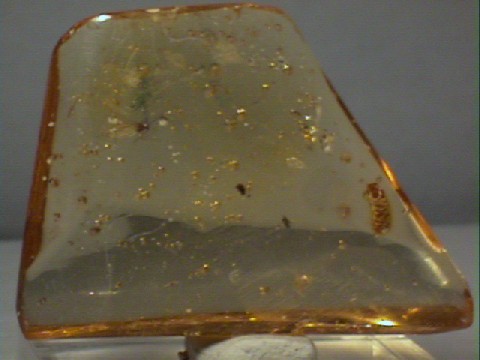
AMBER specimen amb-68
$ 45.00
$ 45.00
Dims:1.6x1.2x0.2" (4.1x3.0x0.5 cm)
Wt: 0.2oz. (7g)
Boyaca, Columbia
This specimen consists of a fully polished piece of Columbian amber, light honey in color. Included within this specimen are three flies. This specimen is of miocene age-approximately 14 million years old.


amb-68 ($ 45.00)
Boyaca, Columbia
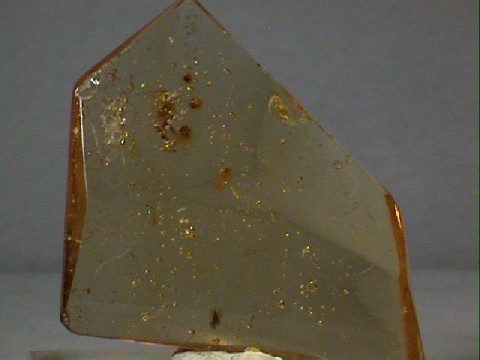
AMBER specimen amb-69
$ 60.00
$ 60.00
Dims:1.4x1.2x0.2" (3.6x3.0x0.5 cm)
Wt: 0.1oz. (4g)
Boyaca, Columbia
This specimen consists of a fully polished slice of Columbian amber. It is of a light honey color. There is an excellent little spider included in this piece, as well as a fly, and some trapped raindrops. This specimen is of miocene age-approximately 14 million years old.
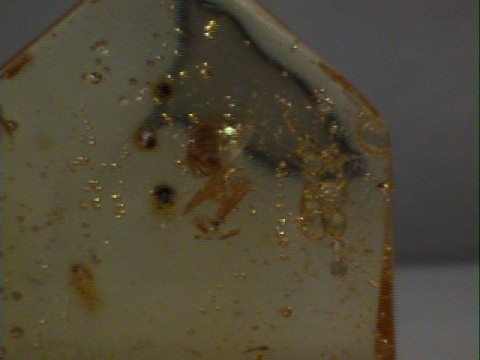

amb-69 ($ 60.00)
Boyaca, Columbia
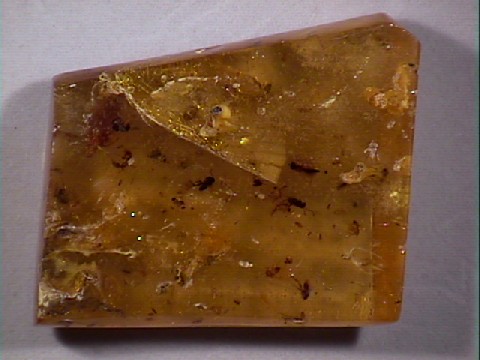
AMBER specimen amb-70
$ 115.00
$ 115.00
Dims: 2.17x1.77x0.59" (5.5x4.5x1.5cm)
Wt: 1.13oz (32.0g)
Boyaca Province, Columbia
This specimen of amber is from an ancient rain forest and is about 23 million years old (Miocene age). I can identify more than 40 insects trapped within, including a leafhopper, some bees, ants, flies, and of course termites. There are a lot of different species present, at least a dozen, and the largest insect is over 1 cm long (not including antennae or wings). A mist of rain likely created the several layers of tiny bubbles that (in the aggregate) slightly cloud the interior of this specimen.
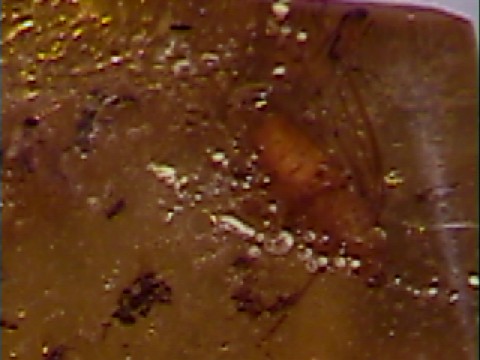

amb-70 ($115.00)
Boyaca Province, Columbia
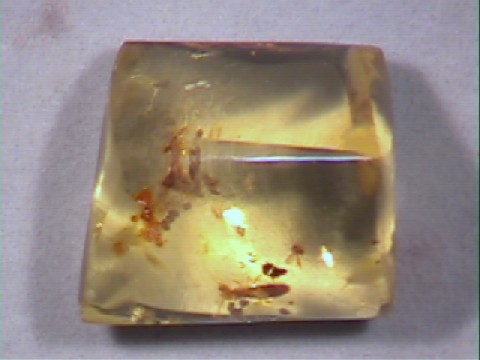
AMBER specimen amb-71
$ 30.00
$ 30.00
Dims: 0.85x0.69x0.57" (2.15x1.74x1.46cm)
Wt: 17.90ct (3.58g)
Boyaca Province, Columbia
This is a miocene amber specimen from Columbia. It is unusually transparent, such that the three entombed insects are exceptionally clear. There is one large termite, and two very small flies, one of which has been preserved very well - it looks like it was caught in mid-flight.

amb-71 ($ 30.00)
Boyaca Province, Columbia

AMBER specimen amb-72
$ 75.00
$ 75.00
Dims: 2.28x1.69x0.63" (5.8x4.3x1.6cm)
Wt: 0.90oz (25.5g)
Boyaca, Columbia
This miocene amber specimen is perhaps 14 million years old. It contains perhaps 2 dozen insects, including a winged termite, flies, a tiny beetle, some odd little insects, and even parts of leaves. There is also a lot of plant litter, and parts of several more insects including legs, antennae, and wings. There is so much stuff here that the amber is rendered translucent, rather than transparent.


amb-72 ($ 75.00)
Boyaca, Columbia
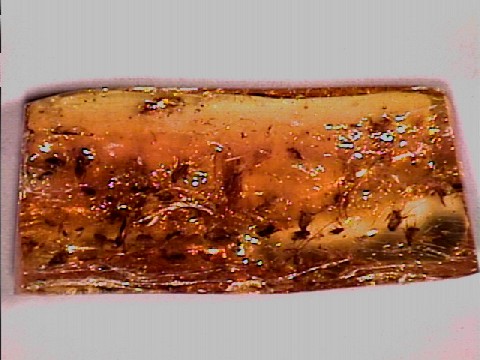
$ 200.00
Dims: 2.24x1.07x0.50" (5.70x2.73x1.27cm)
Wt: 0.43oz (12.1g)
Boyaca, Columbia
This specimen of Miocene amber (about 14 million years old) preserves over 30 insects. There are at least ten different species, including a beetle, a leafhopper, some gnats, a swarm of flies, and a bee. There are also two small spiders. The amber is very clear, and the preservation and quality of the insects is excellent. There are also many tiny fragments of insects present, along with bits of leaves and other plant material. There is an area which shows clear flow patterns of tiny bubbles. This is an excellent specimen with many things to find and examine.
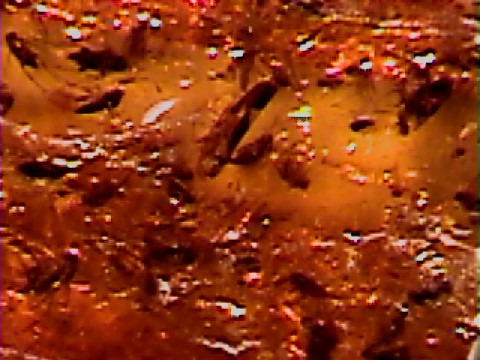

Boyaca, Columbia
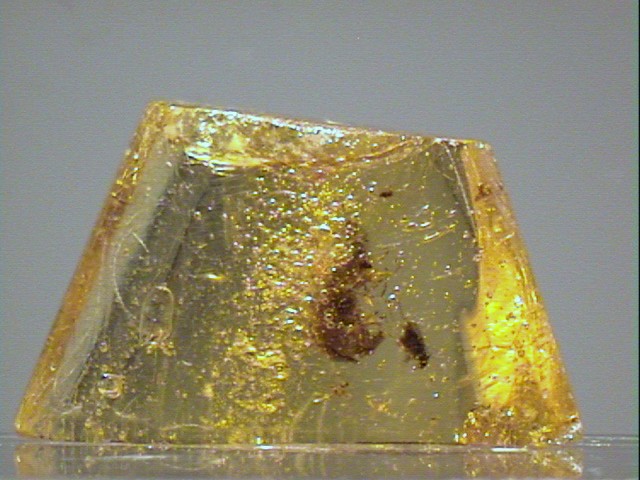
AMBER specimen amb-74
$ 40.00
$ 40.00
Dims: 1.07x0.63x0.45" (2.71x1.60x1.15cm)
Wt: 0.11oz (3.1g)
Boyaca, Columbia
This example of amber is of Miocene age (around 14 million years old), and originated in a tropical rain forest. The amber has preserved at least a half-dozen insects, including several gnats, two flies, and something else which is the largest insect here. The amber is quite clear, and the insects are very well-preserved, yet I cannot identify this insect. The documentation says "beetle", but it does not look like one to me.

amb-74 ($ 40.00)
Boyaca, Columbia

AMBER specimen amb-75
$ 75.00
$ 75.00
Dims: 3.15x1.78x0.76" (8.00x4.53x1.92cm)
Wt: 1.29oz (36.5g)
Boyaca Province, Columbia
This is a piece of amber from the Miocene era - it is about 23 million years old. The amber is transparent but has no many inclusions (most of which are air bubbles) that it appears cloudy, except under a loupe. A few of the insects preserved within are close to the surface and large enough to be easily seen, and a close inspection (a loupe works nicely) reveals that there are dozens of intact insects in at least a half-dozen different species, plus numerous insect fragments (mostly legs), and some very small leaves including some that may be moss (this is rare). I can identify several ants, a small bee and a swarm of tiny ones, a swarm of flies, and several that are extremely small, the tinyiest flying insects that I've ever noticed. This specimen is a rich one for study.


amb-75 ($ 75.00)
Boyaca Province, Columbia
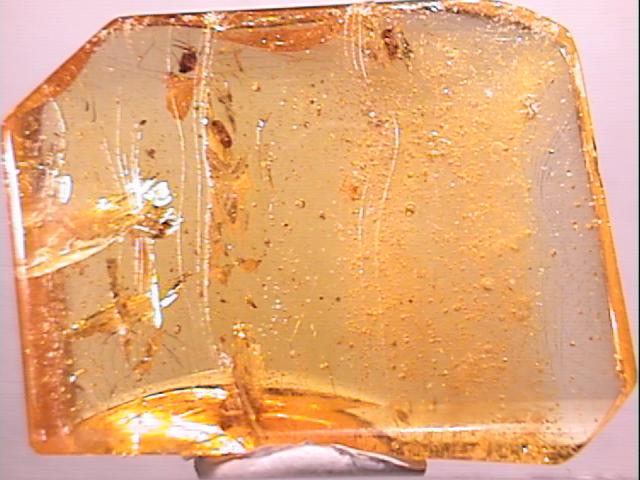
AMBER specimen amb-76
$ 40.00
$ 40.00
Dims: 1.41x1.13x0.38" (3.58x2.87x0.96cm)
Wt: 0.23oz (6.5g)
Boyaca, Columbia
This 14 million year old amber specimen contains at least a half dozen insections, including a spider, an Ambrosia Beetle, three small flies, and a gnat or two. The specimen also contains a lot of air bubbles and bits of what appear to be mold. Some of these may be additional tiny insects.
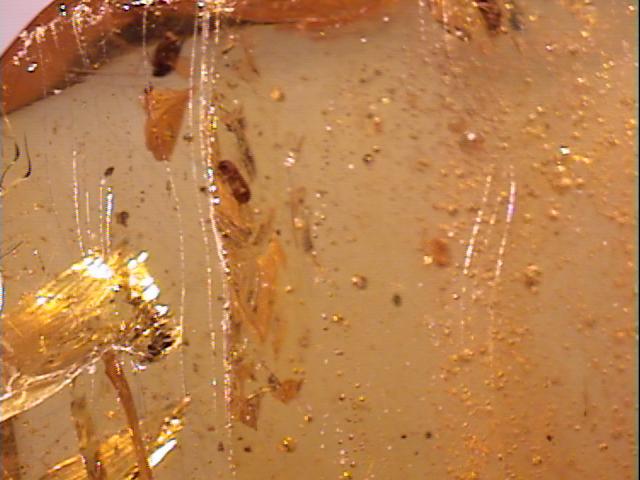

amb-76 ($ 40.00)
Boyaca, Columbia
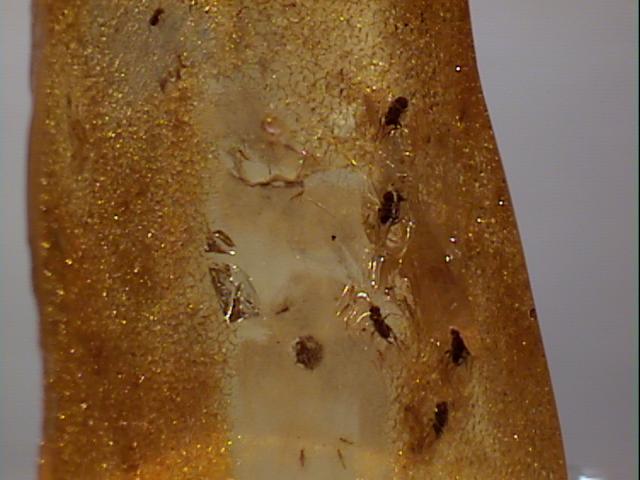
AMBER specimen amb-77
$ 30.00
$ 30.00
Dims: 1.55x0.84x0.42" (3.94x2.12x1.08cm)
Wt: 0.18oz (5.2g)
Boyaca, Columbia
This specimen of amber from Columbia is approximately 23 million years old, dating from the beginning of the Miocene epoch. The base and front has been cut and polished to expose the insects preserved inside. I can see 6 small black flies, at least a dozen tiny gnats, and another small insect that has an extended abdomen like a scorpion, but looks like a flying insect with a stinger or ovipositor.


amb-77 ($ 30.00)
Boyaca, Columbia

AMBER specimen amb-78
$ 25.00
$ 25.00
Dims: 1.18x0.85x0.19" (3.00x2.17x0.49cm)
Wt: 0.06oz (1.7g)
Boyaca, Columbia
This small piece of amber is thought to be of Miocene age, about 14 million years old. It has a single well-preserved small fly, plus a myriad of bubbles and many tiny bits of debris. The fly's wings were folded during its struggles to escape, but it is otherwise in excellent condition.
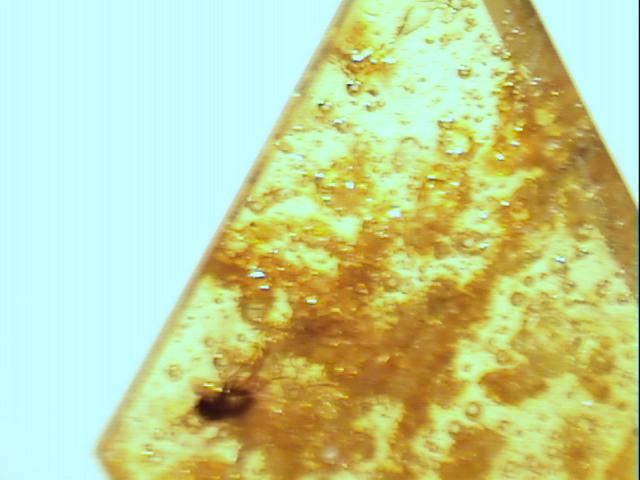

amb-78 ($ 25.00)
Boyaca, Columbia
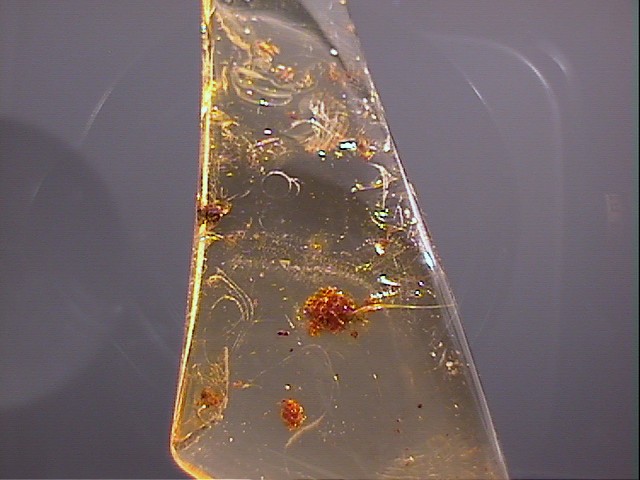
AMBER specimen amb-80
$ 30.00
$ 30.00
Dims: 1.95x0.92x0.37" (4.94x2.34x0.94cm)
Wt: 0.22oz (6.1g)
Boyaca, Columbia
I count six different species of insects in this piece of very clear amber from the Miocene era (about 23 million years old). A few of these, including a tiny beetle and another tiny fly, are very well preserved, although a loupe is needed to examine them closely. All of the insects are small, the size of gnats being the largest.


amb-80 ($ 30.00)
Boyaca, Columbia
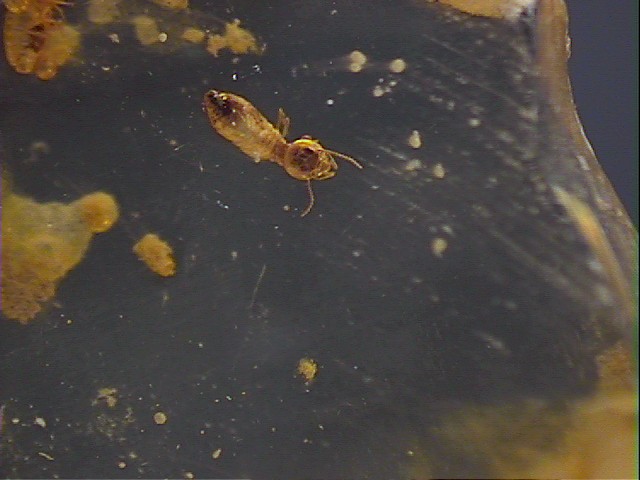
AMBER specimen amb-81
$ 25.00
$ 25.00
Dims: 1.26x1.22x0.33" (3.19x3.10x0.84cm)
Wt: 0.17oz (4.7g)
Boyaca, Columbia
A rough piece of amber has been polished on two sides to reveal a single well-preserved termite. While it is not perfect (a dark discoloration and a lack of bubbles suggest that it dried before being completely entoumbed). There is a second termite off to one side. This amber is Miocene, about 23 million years old.
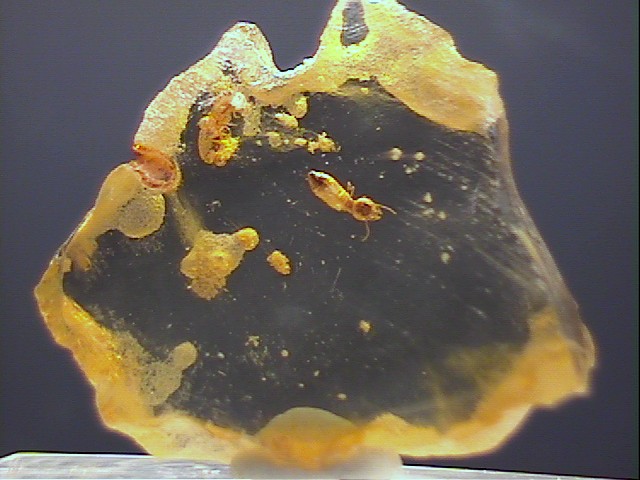

amb-81 ($ 25.00)
Boyaca, Columbia

AMBER specimen amb-83
$ 35.00
$ 35.00
Dims: 1.45x1.15x0.91" (3.69x2.91x2.31cm)
Wt: 0.38oz (10.8g)
Boyaca, Columbia
This exquisitely transparent amber specimen hails from the Miocene era, and is about 23 million years old. It is host to 6 worker termites and numerous bubbles.


amb-83 ($ 35.00)
Boyaca, Columbia

AMBER specimen amb-85
$ 25.00
$ 25.00
Dims: 1.57x0.97x0.57in (3.99x2.47x1.44cm)
Wt: 0.26oz (7.3g)
Boyaca, Columbia
This amber specimen is relatively cloudy, but still there are at least 8 critters preserved within including several flies, at least one spider, and an insect I don't recognise.


amb-85 ($ 25.00)
Boyaca, Columbia

AMBER specimen amb-90
$ 50.00
$ 50.00
Dims: 2.53x1.30x0.41in (6.43x3.30x1.04cm)
Wt: 0.59oz (16.8g)
Columbia
This golden amber specimen contains at least 7 insects of several species, plus it preserves several sets of wings and dozens of raindrops. Most of thee included tiny bubbles are from a light mist that must have settled while the tree sap was flowing.


amb-90 ($ 50.00)
Columbia

AMBER specimen amb-89
$ 40.00
$ 40.00
Dims: 2.58x1.34x0.43in (6.55x3.40x1.10cm)
Wt: 0.54oz (11.0g)
Columbia
This pale peice of amber is very clear (excluding areas showing cloudy sheets) and contains at least 7 insects, three of which are large enough to be obvious to the unaided eye. It is approximately 14 million years old.


amb-89 ($ 40.00)
Columbia

AMBER specimen amb-88
$ 40.00
$ 40.00
Dims: 2.87x1.32x0.63in (7.30x3.35x1.60cm)
Wt: 0.73oz (20.7g)
Columbia
This pale piece of polished amber contains over a dozen insects (mostly flies and gnats), including a winged ant and possibly a mosquito. It is approximately 14 million years old.


amb-88 ($ 40.00)
Columbia

AMBER specimen amb-82
$ 120.00
$ 120.00
Dims: 1.98x1.55x0.78" (5.02x3.94x1.97cm)
Wt: 0.84oz (23.9g)
Boyaca, Columbia
This is a very rich specimen of Miocene amber from Columbia, and it is probably about 14 million years old. The amber is very transparent, although there are so many inclusions that the specimen is almost cloudy. There is at least one ant, one bee, and a small spider. These are accompanied by over 2 dozen flies of many different species. A high-power loupe is needed to appreciate this sample, as most of the insects are very tiny.


amb-82 ($120.00)
Boyaca, Columbia

AMBER specimen amb-91
$ 40.00
$ 40.00
Dims: 2.91x0.74x0.36in (7.40x1.88x0.92cm)
Wt: 0.30oz (8.6g)
Columbia
A long, narrow piece of polished amber contains 6 tiny flies and several pieces of plant matter, and something large and unidentified which appears to have a fungus.


amb-91 ($ 40.00)
Columbia

AMBER specimen amb-92
$ 60.00
$ 60.00
Dims: 3.16x2.21x0.44in (8.03x5.63x1.11cm)
Wt: 1.00oz (25.4g)
Columbia
This piece of amber may be pale, but it is full of treasures. It preserves over 2 dozen insects, plus 2 spiders, a larva of some type, a couple of seed pods, and a dozen or more exquisitely preserved rain drops, many in the shape of tiny rings.


amb-92 ($ 60.00)
Columbia

AMBER specimen amb-86
$ 35.00
$ 35.00
Dims mm=32.57x28.20x10.19
wt g=5.9
Boyaca, Columbia
One ant and a half dozen flies of various species are preserved within this specimen of amber from an ancient rain forest in Columbia. It is of Miocene age, around 14 million years old.


amb-86 ($ 35.00)
Boyaca, Columbia

AMBER specimen amb-87
$ 25.00
$ 25.00
Dims mm=18.24x17.03x16.25
Wt g=4.5
Boyaca, Columbia
This cube of Miocene amber preserves two worker termints, and one of the termites has a perfectly preserved tiny mite on one antennae! The mite is barely visible to the unaided eye, and a high power loupe shows excellent details.


amb-87 ($ 25.00)
Boyaca, Columbia